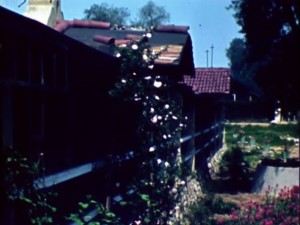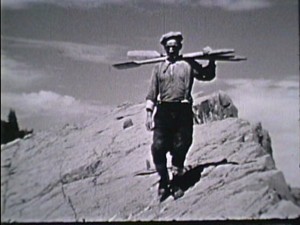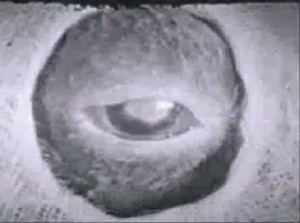
"Footage of various California missions [...] from the late 1930s." Archive.org
"Item is a film taken by Dr. Willinsky of a trip to Rome, Italy. In the form of a travelogue, footage of landmarks, ruins and the local population are interspersed with captions that were added in by Dr. Willinsky to provide information about the country's history and culture. Included are shots of the Pantheon, the Colosseum, a Roman market, the Appian Way and dinner at a Roman restaurant. Dr. Willinsky's wife, Sadie, is occassionally spotted in the footage with travel companions who are probably relatives or family friends." Ontario Jewish Archives.
"Among the Ten Best, A Christmas at Home, by Edmund Zacher, II. ACL. is a lovely mine of bright gems which glows with all the warmth and color so surely associated with this festive season. Although essentially of slow pace, the film never once loses appeal, as it presents with loving and tender enthusiasm the countless minutiae of beauty which blend into the charm of Christmas at home. Mr. Zacher's color photography, predominantly interior, is crisp and delicately beautiful, while his sensitive selection of material and cunning choice of angles are an unfailing delight. Multiple exposures of such charm and flawless craftsmanship as almost to defy detection adorn his opening and closing sequences, and the entire production is pleasantly scored with appropriate music and sound effects. More than once a previous winner in these annual selections, Mr. Zacher seems not yet to have reached the full measure of his fine skill with camera and film." Movie Makers, Dec. 1935, 534.
"One of the most difficult of amateur subjects, a record of a child's vacation, is presented most ably in Adirondack Adventure, by Frank Gunnell, ACL. The photography was a joy to behold and showed quite clearly that a great deal of care and experience was back of it. Fine outdoor lighting, which made the most of every scene, predominated. The continuity of this competent picture was developed in such a fashion as to feature Mr. Gunnell's small son naturally and unobtrusively. Incidents which make up the picture are handled clearly and yet with a light touch. Only a movie maker would appreciate the fact that the sequences were far from casual but, instead, were staged carefully. The real charm of a summer vacation has been preserved in this fine picture." Movie Makers, Dec. 1935, 534.
"Children Grow Up, photographed by Charles J. Carbonaro, ACL, and produced by The Religious Motion Picture Foundation, is one of the best examples of effectively handling amateur actors in a story telling film yet made. This three reel film was avowedly produced to point a moral in parent and child relationships and, as such, may be classed as social propaganda, a function in which it succeeds admirably. Yet the story it tells seems genuine and is of general audience interest. The film is carefully cut so that the action is logical and smoothly paced. Mr. Carbonaro is particularly to be congratulated for his handling of the difficult technique of parallel action, which occurs as the development of the children of two separate families takes place. Both streams of interest merge into one in a well planned, dramatic climax. The story is told entirely with the aid of amateur actors. Interior shots are in the majority and, for these, no special sets were built, the furnishings of the ordinary home being used. The lighting and exposure under these conditions are excellent throughout." Movie Makers, Dec. 1935, 534.
"Christmas Nuts, presented with a sound on film recording on a separate 16mm. film, produced by Paul Braun and Howard Goodman, is not only an interior color picture of exceptional beauty and impeccable technical quality but is also one of the best puppet films thus far created. With a camera technique paralleling that of the latest theatrical, animated talkie cartoons, the story of a wolf "hijacking" Santa Claus and the consequent near calamity for the two squirrels is unfolded in a completely cinematic fashion. The camera moves freely from medium shot to closeup, the mechanics of the sets are not obstrusive and the puppets move with agility and grace. The sets, which were designed and constructed with great care, are very handsome and exquisitely finished so that no imperfections are revealed in the enlarged picture of them on the screen. The sets, in combination with the colored lights used in part to illuminate them, embody the producers' theory of "created color." That is, no attempt is made to simulate nature, but rather to produce pleasing, vivid color combinations, as in the illustrations of a child's story book. A cleverly compiled dialog, song and music accompaniment has been synchronized with the picture, although recorded, at present, on a separate film." Movie Makers, Dec. 1935, 534.
"Structurally sustained by only the slimmest of plot incidents, Dummy Walks Out is in essence an etude in cinematics, sparkling with brilliant photography and bravura with striking angles. An evening of bridge, consistently bad cards to one player and, in time, the dummy walks out — such is the simple scheme of this masterpiece in miniature. Throughout its brief footage, however, the producers, M. P. Gamber. ACL, and Walter Mills, ACL, have contrived a gleaming glossary of cinematic imagination which delights the eye and beggars analysis. Near shot, closeup and extreme closeup (in several scenes, a single playing card fills the entire screen) follow one another with graphic beauty. Dummy Walks Out is a brilliant answer to the timid souls who "alibi" that the Eights can't take it." Movie Makers, Dec. 1935, 534, 550.

"In Fishers of Grande Anse, Leslie P. Thatcher, ACL, has compiled a vivid and crystal clear cinematic document of cod fishing in a little village in northern New Brunswick. This picture is a restrained work of art that depicts the austere beauty of toil. Repairing boats and nets, catching and cleaning the cod, salting and storing the fish for market and the fishermen leaving for home are the raw material from which this black and white production draws its rugged and satisfying beauty. Close shots and closeups (never affected or forced) comprise the simple devices whereby the irrelevant and possibly distracting material is excluded and whereby the magnificent compositions are achieved. The technical quality of the picture is superb, but probably Mr. Thatcher's greatest accomplishment is in his choice of camera viewpoint." Movie Makers, Dec. 1935, 550.
"In the Beginning, although far from being a perfect picture, is nevertheless one of the few truly great films thus far to come from a motion picture camera — either theatrical or amateur. Here, the magnificent beauty and awesome strangeness of the natural world have been seen in their fundamental and ultimate meanings. As an interpretation of the epic story of creation, In the Beginning follows directly in the noble tradition of Homer, Dante and Milton. One is left stilled and humble before the simple purity of imagination which conceived it. To this superb document of nature, F. C. Ells, ACL, the producer, has brought a technical skill and sensitive craftsmanship more than equal to the demands of his subject. Using as his titles direct quotations from the first chapter of Genesis, Mr. Ells has added a subtle undertone to the beautiful King James English by the use of primitive, geometrical symbols (indicative of fire, rain, infinity, etc.) for his title backgrounds. Somber and stunning scenes of the heaving waters, the new born earth and bursting streams in the first reel are followed, in the second, by flawlessly executed telephoto and macroscopic studies of the earth's myriad creatures. Integrating the entire production is a musical accompaniment of stately church music, recorded on disc by the Sistine Choir. Mr. Ells, who has looked upon the earth and found it good, has produced a sincere and beautiful film, great even as it falls short of perfection." Movie Makers, Dec. 1935, 550.

"Keratoplasty, by Henry M. Lester, ACL, is a beautifully perfect record of the operation of a corneal transplant for leucomateous eyes, filmed entirely in Kodachrome. The operation is performed by Dr. Ramon Castroviejo, a rabbit being the subject. Aside from the fact that this clearly executed film records an important and extraordinarily difficult operation in this field, it is notable for its brilliant photographic technique in handling the ultra closeup. In much of the footage, the eye itself practically fills the frame and, in this limited field of action, Mr. Lester has successfully shown every delicate bit of operative technique that is involved in this extremely sensitive surgical procedure. The area is so lighted that no shadows are cast to obscure detail, and the amazing rendition' of the delicate bit of transplanted tissue, the suturing and the various solutions employed, all in full color, is a genuine tribute to Mr. Lester's mastery of the Kodachrome process." Movie Makers, Dec. 1935, 550.
Total Pages: 299